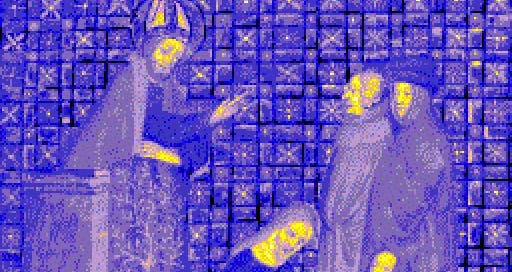Church Bulletin Design is Bad, and That's Good
A bonus Wednesday short post: computing's design implies computing's anthropology.
Your church bulletin's graphic design is probably pretty bad. It's scattered, it's unprofessional, it probably uses too many fonts and colors. But that bad design is what makes it a good design.
A son who is embarrassed because his crayon-drawn stick figures on the fridge are not photorealistic has mistaken the relationship he is in. He, as a son, is in a relationship that does not consist of his techne of the use of dyed wax to express the play of light on his mother's hair, but a relationship that loves him for who he is, of which his re-expression of the family holding hands is in fact a far clearer expression of that love than any clever use of wax could indicate.
My temptation to roll my eyes at yet another mis-aligned text box or poor font choice looks at my parish like a business. A business does graphic design as a delight to the eyes,1 to serve others for the sake of serving oneself. The parish, like the family, inverts that relation, where serving the self (if it can be called that) flourishes into serving others.2
The church bulletin ought not be professional, but rather amateur - it is done by an amator, a lover, in the image of Him Who is Love. The mixed colors and incomplete alignment are - in some ways - an old city street with its various materials and charm, growing organically, dynamically, fractally - as a family does. The aesthetic sensibilities of each different announcement reflects the walks of life the parishioners come from.
Is there value in good graphic design? Of course. But it has the temptation to turn the subject of the design into a commodity to be sold. The problem is not designing, it is how the design is happening.
What does this have to do with computing? Computing takes two roles in the bulletin. First, it is the means for printing and distribution. To print so many copies so often lends itself to digital design. It also sets the structure of the bulletin: the rectangular images, the rectangular pages. And yet simultaneously it is also the tool that the parishioners used to make the varied images and graphics that represent the parish and their activities.
But does the computer help us love?
This question almost appears to be a non-sequitur. Where is love here? Where could love even be? Our current inability to answer this question convincingly is rooted in utilitarian ways of reasoning about the computer's impact. Utilitarianism collapses moral questions into giant math equations: the most good for the most people. This flattens the dynamic, hierarchical world into a flat, regularized spreadsheet.3 Can we really add up all the good things about computing, add up all the bad things, and select the greater quantity?4
Here's a better question - what would one even do with that knowledge? The questions that face us regarding our relationship with computing are varied and diverse because we are a varied and diverse people in varied and diverse circumstances. Computers are not used in the abstract, they are used in particular, concrete cases of life. What guides us in our judgment of these concrete cases are the characteristics, principles, and norms about computing.
In order to make sense of computing, we need to place the use and the form in right relation to one another. The form of the computer - perhaps it is better to say its design - is what determines its use, and we come to know its form through its use. The form of a thing is not separate from its end: the medium is indeed the message.5
Upon seeing the bulletin, I am tempted to consider the parish as a business because the computer that designed that bulletin is a business tool. Its origins were mathematical, its childhood was military, its adolescence was industrial, and its adulthood is commercial. The aesthetics that pervade the software for making computer documents - left align, boxes, right angles, columns, white space - are designed for readability measured with assumptions that the reader is rushed and bored and has no relationship with the writer. This is the anthropology of mass production, advertising, and factory work. The smartphone was designed for the office; no wonder its use has extended the office into every room in the house.
The bad graphic design of the bulletin is good because it reflects the parish as amateurish, in an image of God the Ultimate Amateur. It instantiates a Christian perseverance - perhaps even a Christian resistance - against the computer's ideology. The temptation to view the bulletin as something that ought to be professional comes from many directions, one being the very mechanism by which we produce the bulletins: that is, computing. Yet as articulated earlier, computing at its root is good. It is possible to pursue the goods that computing seeks to attain - and even attain them better - if computing is instead set on Christological foundations both in its principles and its practices.
Do you think Full Stack Theology is a good use of computing? If so, considering subscribing and sharing with the technologists in your life. Thank you!
Yes, this is a reference to Genesis 3. No, doing business is not evil, but it does (like computing) have serious temptations that have baked themselves into our lives.
Mark 6:30-32.
I love spreadsheets. Don't make moral decisions with them, though.
No, we can't - but that's not a particularly convincing argument to make when it's easy to envision it "in principle."
Somehow I spent five years working a Communication department at a university without learning Marshall McLuhan was a devout Catholic.




